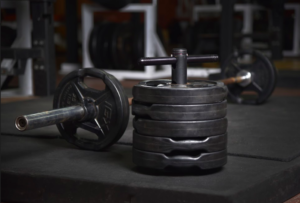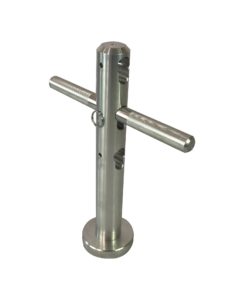One of the biggest concerns among parents, coaches, and youth athletes is the potential for injuries associated with child and youth weight training.
Many studies have demonstrated that most injuries sustained by young weight lifters and power lifters are caused by incorrect lifting techniques, often due to improper or insufficient supervision, or lack of trained, qualified adult instruction.
It is, therefore, fundamentally important that a good weightlifting regimen for youth provide all the tools necessary to master the sport of weightlifting, building physical strength and resistance while bypassing preventable injuries.
Enter the T-Bell.

The T-Bell was created by a former collegiate football player and former coach who underwent one back surgery, two reconstructive shoulder surgeries, and five knee surgeries.
He designed it to help himself resume an active athletic lifestyle while recovering from surgery. The T-Bell allowed him to lift without loading stress on his spine, meaning he could lift pain-free and protect his vulnerable spine from injury. As a former youth coach, he also sought to respond to the huge void he noticed in secondary schools and other training organizations with regard to training youth in weightlifting.
The T-Bell is a versatile…
…multi-purpose progression bar that is used in the early stages of weight training, especially when deadlifting, to teach young athletes safe and proper lifting techniques. The T-Bell is not designed to be a replacement for the standard barbell, but is rather a learning tool to teach and encourage proper lifting techniques and proper bio-mechanical function when lifting.
Once the young athlete has achieved mastery of lifting with the T-Bell, he or she can safely progress to lifting with a standard barbell while preventing potential musculoskeletal injury.
The deadlift and its many variations are among the most crucial exercises in the foundation of any weightlifting program. The deadlift is one of the most basic exercises in the sport, and also the base for all other types of ground lifts in weightlifting, so mastery of this exercise is essential to proper performance of many other major lifts.
It benefits the body and builds core strength by engaging and stabilizing trunk muscles, while exerting large amounts of force in the extremities – meaning that it impacts the entire body, engaging many motor units and muscle fibers.
It also helps to develop muscoskeletal coordination, and helps build adaptability and long-term resistance, contributing to increased strength and improved coordination in weightlifting as well as in other sports. Proper posture and lifting technique, as well as proper foot pressure and centering of weight, is of utmost importance when performing basic weightlifting exercises in order to prevent injuries, particularly in such physically demanding exercises as the deadlift and its variations.
The biggest risk to youth athletes when working out in a weight training program is musculoskeletal injury, such as bone fractures, low back bony disruptions, and spinal injuries such as a ruptured or herniated disk, which also causes low back pain, muscle strain, and decreased physical performance.
 The T-Bell protects beginning lifters from spinal injury and muscle strain by strengthening and building core muscles surrounding the spine without stress loading the vertebrae and spine itself.
The T-Bell protects beginning lifters from spinal injury and muscle strain by strengthening and building core muscles surrounding the spine without stress loading the vertebrae and spine itself.
The T-Bell also provides the advantage of bringing the weight closer to your center of gravity, which encourages proper foot pressure and provides a sturdy and solid base for the trunk muscles during the deadlift and squat.
By centering the weight on the hip structure and in line with the spine, the T-Bell develops and strengthens the core before putting weight and stress on the outer extremities. This helps to further stabilize the trunk and spine, protecting against spinal injury and muscle strain. By placing the emphasis on proper foot pressure for deadlifting and squatting, or “lifting from the ground up,” the athlete works from a sturdier base with a decreased risk of injury caused by stress-loading disks.
The T-Bell effectively fortifies and develops the posterior chain of muscles in the body, which is the muscle group that most affects your posture and spinal health. This group of muscles consists of the lower back, gluteus muscles, and hamstrings, which exert a powerful influence on an athlete’s posture, strength, endurance, and general athletic and physical performance.
The T-Bell may be used to enhance and protect athletes while performing a variety of exercises, including the deadlift, squat, single leg deadlift, RDL (The Romanian Deadlift), biceps, upright row, abs, and kettlebell swings.
The ideal training solution for all lifters, the T-Bell is particularly useful and beneficial for beginners – especially for children and teens who are new to weightlifting, because it programs the body to activate the proper set of muscles required for safe lifting.
By developing this habit early in the athlete’s training experience, the body will naturally engage the proper muscles once the athlete transitions to a lifting with a standard barbell. This gradual development of core muscles contributes to increased lifting power, stamina, and endurance, benefitting the athletic performance of anyone who uses this simple and safe system of early training.
For information about the T-Bell, [click here].
Robert Acuña Jr. is a Former 3 Time All-Conference College Offensive Lineman, Former All-Region College Offensive Lineman, Former Junior High & High School Coach and Creator of nextlevel.training
Gumbs VL, Segal D, Halligan JB, et al. Bilateral distal radius and ulnar fractures in adolescent weight lifters. Am J Sports Med. 1982; 10: 375-379.
Wenning, Matthew, MS, The Deadlift and Its Application to Overall Performance. The Journal of Strength and Conditioning Research. 26(3): 867-872, 2012.
Brady TA, Cahill BR, Bodnar LM. Weight training-related injuries in the high school athlete. Am J Sports Med. 1982; 10: 1-5.

2 thoughts on “The T-Bell: Proper Mastery of the Deadlift Prevents Injuries in Youth Athletes”
Comments are closed.